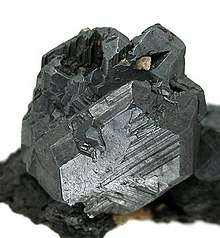
Back كالكوسيت Arabic Xalkozin Azerbaijani Хальказін Byelorussian Халкоцит Bulgarian Calcocita Catalan Chalkocit Czech Chalkosin German Χαλκοσίνης Greek Calcosina Spanish Kalkozita Basque
| Chalcocite | |
|---|---|
 Chalcocite from Cornwall | |
| General | |
| Category | Sulfide minerals |
| Formula (repeating unit) | copper(I) sulfide: Cu2S |
| IMA symbol | Cc[1] |
| Strunz classification | 2.BA.05a |
| Crystal system | Monoclinic |
| Crystal class | Prismatic (2/m) (same H-M symbol) |
| Space group | P21/c |
| Unit cell | a = 15.246(4) Å, b = 11.884(2) Å, c = 13.494(3) Å; β = 116.35(1)°; Z = 48 |
| Identification | |
| Color | Dark gray to black |
| Crystal habit | Tabular to prismatic crystals also massive to granular, (pseudo-orthorhombic) |
| Twinning | Common on {110} yielding pseudohexagonal stellate forms |
| Cleavage | Indistinct on {110} |
| Fracture | Conchoidal |
| Tenacity | Brittle to sectile |
| Mohs scale hardness | 2+1⁄2–3 |
| Luster | Metallic |
| Streak | Shiny black to lead gray |
| Diaphaneity | Opaque |
| Specific gravity | 5.5–5.8 |
| Fusibility | 2–2.5 |
| References | [2][3][4][5] |
Chalcocite (/ˈkælkəˌsaɪt/),[6][7] copper(I) sulfide (Cu2S), is an important copper ore mineral. It is opaque and dark gray to black, with a metallic luster. It has a hardness of 2.5–3 on the Mohs scale. It is a sulfide with a monoclinic crystal system.
The term chalcocite from the Greek khalkos, meaning "copper". It is also known as redruthite, vitreous copper, or copper-glance.[8]
- ^ Warr, L.N. (2021). "IMA–CNMNC approved mineral symbols". Mineralogical Magazine. 85 (3): 291–320. Bibcode:2021MinM...85..291W. doi:10.1180/mgm.2021.43. S2CID 235729616.
- ^ Mineralienatlas
- ^ Mindat.org
- ^ Webmineral.com
- ^ Handbook of Mineralogy
- ^ "chalcocite". CollinsDictionary.com. HarperCollins.
- ^ "chalcocite". Dictionary.com Unabridged (Online). n.d.
- ^ Chisholm, Hugh, ed. (1911). . Encyclopædia Britannica. Vol. 7 (11th ed.). Cambridge University Press. p. 110.